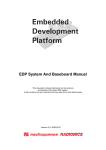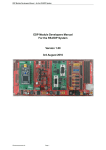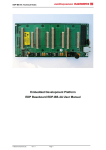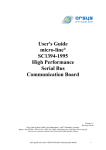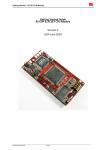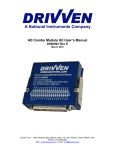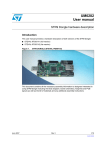Download EDP-CM-STR9 CPU Module User Manual Version v4
Transcript
EDP‐CM‐STR9 CPU Module User Manual Version v4 This document contains information on the STR9 module for the RS EDP system. EDP-CM-STR9 Manual Contents 1. EDP-CM-STR9 CPU Module 3 2. Get The Latest Versions 3 3. Module Features 4 4. 4.1 4.2 4.3 4.4 4.5 Pin Mapping 5 MCU Pin Allocation........................................................................ 5 Backplane Resources Used by the CPU Module......................... 10 Backplane Signal Names and Connections ................................. 13 Alphabetical Listing of MCU Pins................................................. 16 Mapping Aids............................................................................... 21 5. 5.1 5.2 5.3 5.4 5.5 5.6 STR9 Module Selectable Jumpers 22 B200-B125 Solder Bridges .......................................................... 22 X300 Analog Reference Voltage.................................................. 23 B300 & B301 Virtual Comms Ports .............................................. 23 X401 Ethernet Enable/Disable..................................................... 23 X402 Local CAN Transceiver....................................................... 23 STR9 Analog Grounding Arrangements ...................................... 24 © Electrocomponents plc Page 2 EDP-CM-STR9 Manual 1. EDP-CM-STR9 CPU Module The STR9 module uses development tools for ARM CPUs. The recommended tool chains are as follows... • Keil uVISION IDE with ARM RealView compiler • HitopARM IDE based on the GNU-C compiler. Other toolchains may be used but there are no specific examples provided for them. The Keil uVISION is designed to work with several types of JTAG tool, the most popular being the ULINK2 JTAG debugger. The ULINK2 tool can be used with all ARM7 variants, ARM9, Cortex M0 and Cortex M3 series cores. On later Cortex M series devices the ULINK2 can switch modes from JTAG to SWD which is the new Serial Wire Debug standard. The ULINK2 is not sold with the STR9 module but can be purchased separately from one of Kiel’s distribution agent. This is the best solution for development with the STR9 module as it means only one IDE is used in the development process. Keil uVISION can be used in both simulator mode and also in hardware debug mode, using the actual hardware to single step through the code etc. Keil uVISION can also be used to generate an output debug file (ELF/DWARF format) which can be used by other IDEs such as HiTOP for ARM, which is Hitex’s own proprietary debugger. With this in mind you can use the Keil uVISION IDE to do the code writing and editing, and then HiTOP for programming and debugging. The big advantage of doing this is that HiTOP for ARM works with a JTAG debugger which is present on the STR9 module. This is basically an FTDI chip with an on board wiggler which acts as a programmer and debug interface. This means you do not need to purchase an additional hardware debug/programmer tool as it is already built into the STR 9 module. What is more the FTDI chip has a second uncommitted RS232 channel, which can be used by the user as a virtual comm. port. This means if you set up the STR9 module correctly and connect the UART Rx and Tx traffic to route this chip, then you can effectively get a virtual UART port for free. This means through the one mini USB connection you have both a debugger and a virtual communications port. This also means if you want to view serial traffic, you do not need to purchase a Communication Module. This is described later. 2. Get The Latest Versions Always visit the EDP support website for the latest versions of the tools and examples. This is frequently updated and contains huge amount of useful information. Hitex currently provide an RSEDP support page and this is on... www.hitex.co.uk/edp RS will also provide support for the RS-EDP platform on their own web site. It is envisaged that RS site will replace the Hitex web site and become the sole repository of information on the RS-EDP platform. No URL exists (web address) at the time of writing this manual. The key documents that are available for the RS-EDP platform are as follow... • • • Spec Sheet This is a single page document detailing the features of the module. Each AM and CM has its own spec sheet. User Manuals A user manual is provided for each module. This is a detailed description of the module, how to configure it plus the circuit diagram and component overlay drawings for that module. Mapping Aid This item describes how the modules interconnect with each other via the backplane. By examining this document it is possible to see at a glance which features of the Applications modules are accessible via the CPU Module. © Electrocomponents plc Page 3 EDP-CM-STR9 Manual • • 3. Pin Allocation Spreadsheets This document shows which pins of the MCU are allocated to which function on the RS-EDP backplane. It details more thoroughly the relationship between the MCU and the Back Plane function than the mapping aid. This document is only available for the CPU Modules Software downloads Example software of using the CPU Module with the other RS-EDP modules. Module Features STR912 CPU Module Part Number EDP‐CM‐STR9 Features Comment ARM9 CPU at 96MHz, 3V3 512k bytes on board FLASH 96k on board SRAM External 1M bit SRAM, 3V SRAM 1x CAN transceiver with PESD2CAN protection 25MHz XTAL 32kHz XTAL for RTC USB ESD protection on USB +/‐ pins STE100P PHY 1.8V core regulator FTDI USB‐JTAG and ASC1 interface ARM966 Core, 128TQFP package Raw JTAG connector (0.05" socket) Raw ETM trace connector (Mictor socket) User LED, Power On LED ResetIN LED ResetOUT LED © Electrocomponents plc Arranged as 64kx16, <25ns, Chipselect = CS0 Local CAN transceiver CPU Runs at 96MHz 32KHz for Real Time Clock Ethernet 10/100M bit For use with HiTOP ARM IDE Samtec FTSH. 0.1" JTAG adaptor available Optional fitted part for Extended Trace Macrocell Yellow (Port 7.0) Blue Orange Red Page 4 EDP-CM-STR9 Manual 4. Pin Mapping The STR9 is a high integration MCU device with 128pins. Many of the pins have more than one function for both the MCU and also within the RS-EDP system. This means that not all of the functions are available all of the time and system designer has to take care to ensure the key features of his system are implemented at the expenses of the less important ones. Some compromise has to be made by system user to accommodate the fixed mapping which you see below. For example the virtual comm. port uses ASC1_Rx and ASC1_Tx pins which are also used by the Ethernet controller. This means for systems which use the Ethernet device, the user cannot use the virtual communications port. However serial comms is possible on ASC0 channel and therefore the user can have both Ethernet and RS232 comms with the addition of a Communication Module. 4.1 MCU Pin Allocation Pin 1 STR912 Name P4.2 2 P4.1 3 P4.0 4 5 AVSS Analog GND P7.0 6 P7.1 7 P7.2 8 9 10 VSSQ ‐ GND for I/O VDDQ 3.3 I/O P2.0 11 P2.1 12 13 14 15 16 17 18 19 P5.0 P7.3 P7.4 P7.5 VSS ‐ GND for CPU VDD ‐ 1.8V CPU P5.1 P6.2 20 P6.3 21 22 23 24 EMI_BWR_WRLn EMI_WRHn VDDQ 3.3 I/O VSSQ ‐ GND for I/O © Electrocomponents plc Comment 3 hard wired 3 hard wired 3 hard wired 2 hard wired 2 hard wired 4 hard wired 4 hard wired 4 hard wired 4 hard wired 2 hard wired 2 hard wired 2 hard wired 2 hard wired 2 hard wired 2 hard wired 2 hard wired 2 hard wired 2 hard wired 2 hard wired 3 hard wired 3 hard wired 3 hard wired 2 hard wired 2 hard wired RS‐EDP Backplane Function AN2 EVG3_GPIO46 EVG11_GPIO59 AN1 EVG1_GPIO42 AN0 EVG0_GPIO40 EVG2_GPIO44 EVG9_GPIO57 VAGND MOTORH0_ENC0 EVM2_GPIO41_CAPADC MOTORH1_ENC1 EVM3_GPIO43 MOTORH2_ENC2 EVM4_GPIO45 SGND 3.3V I2CGEN1_SCL CNTRL_I2C_SCL I2CGEN1_SDA CNTRL_I2C_SDA ASC0_TX_TTL EVM5_GPIO47 IRQ_GPIO22_I2C_INT IRQ_GPIO20_I2C_GEN1_INT SGND 3.3V ASC0_RX_TTL MOTORP1H CPU_DAC01_GPIO19 EVG14_GPIO62 MOTORP1L EVG16_GPIO64 #WR #WRH 3.3V SGND Page 5 EDPCON 1 5 67 80 4 63 3 61 65 78 19 116 62 118 64 120 66 131 127 119 EDPCON 2 127 79 & 80 77 & 78 47 & 48 49 & 50 131 117 91 68 43 41 131 127 89 106 40 83 104 85 EDP-CM-STR9 Manual 25 PHYCLK & P5.2 local Ethernet Not all of the IO pins on the MCU are mapped to the backplane. Some pins use the local resources present on the STR9 module. In the tables below you will find that some of the backplane functions are hardwired to each other. Where this is the case the phrase ‘hard wired’ is used. This means these backplane functions are not independent of each other and cannot be separated. The user must therefore be careful on contention between Application Modules, which may effectively try and independently use these signals. Where the user can separate the functions, the phrase ‘link options’ is used. Where the situation is referred to as ‘options’ it means the situation is more complicated. You will need to refer to the Mappping Aids or the circuit diagram for more details on how the pins are used and connected. Pin 26 STR912 Name P8.0 27 28 P5.3 P8.1 29 P6.0 30 P8.2 31 P6.1 32 P8.3 33 34 P2.2 P8.4 35 36 P2.3 P8.5 37 38 P2.4 P8.6 39 40 41 42 43 44 VBATT ‐ for RTC VSSQ ‐ GND for I/O X2_RTC X1_RTC VDDQ 3.3 I/O P8.7 45 46 P2.5 P9.0 47 P9.1 48 49 VSS ‐ GND for CPU VDD ‐ 1.8V CPU © Electrocomponents plc Comment 3 options 3 options 3 options 3 options 3 options 3 options 3 hard wired 3 hard wired 3 hard wired 3 options 3 options 3 options 2 hard wired 2 hard wired 3 options 3 options 3 options 3 options 3 options 3 options 2 link options 2 link options 2 link options 2 link options 2 link options 2 link options 2 link options 2 link options 2 link options 2 link options RS‐EDP Backplane Function GPIO0 GPIO38_AD0 A0_AD0 local Ethernet GPIO1 GPIO36_AD1 A1_AD1 MOTORP0H CPU_DACO0_GPIO17 EVG10_GPIO58 GPIO3 GPIO34_AD2 A2_AD2 MOTORP0L EVG12_GPIO60 GPIO6_MCI_DAT2 GPIO32_AD3 A3_AD3 I2C_GEN0_SCL GPIO4_MCI_DAT1 GPIO30_AD4 A4_AD4 I2C_GEN0_SDA GPIO28_AD5 A5_AD5 CNTRL_SPI_CLK GPIO26_AD6 A6_AD6 3V BAT SGND local Xtal local Xtal 3.3V GPIO24_AD7 A7_AD7 CNTRL_SPI_MTSR EVG0_GPIO40 A8_AD8 GPIO37_AD9 A9_AD9 SGND Page 6 EDPCON 1 21 59 22 57 102 38 79 24 55 100 81 27 53 25 51 49 47 124 131 127 45 61 58 131 EDPCON 2 41 & 42 39 & 40 37 & 38 35 & 36 7 & 8 33 & 34 5 & 6 31 & 32 69 & 70 29 & 30 27 & 28 73 & 74 25 & 26 23 & 24 EDP-CM-STR9 Manual 50 P9.2 © Electrocomponents plc 2 link options 2 link options GPIO35_AD10 A10_AD10 Page 7 56 21 & 22 EDP-CM-STR9 Manual Pin 51 P9.3 52 P9.4 53 54 55 56 57 58 P2.6 P2.7 &b USBCLK P3.0 VSSQ ‐ GND for I/O VDDQ 3.3 I/O P9.5 59 60 61 62 P3.1 P3.2 P3.3 P9.6 63 P3.4 64 P9.7 65 P3.5 66 P3.6 67 68 P0.0 P3.7 69 P0.1 70 71 72 P5.4 P0.2 VSSQ ‐ GND for I/O VDDQ 3.3 I/O EMI_ALE EMI_RDn 73 74 75 STR912 Name © Electrocomponents plc Comment 2 link options 2 link options 2 link options 2 link options 2 link options 2 link options 2 link options 2 link options 2 hard wired 2 hard wired 2 link options 2 link options 2 hard wired 2 hard wired 2 hard wired 2 hard wired 2 hard wired 2 hard wired 2 hard wired 2 hard wired RS‐EDP Backplane Function GPIO33_AD11 A11_AD11 GPIO31_ADI2 A12_AD12 CNTRL_SPI_MRST CNTRL_SPI_#CS_NSS ASC1_TX_TTL_ASC0_DTR EDPCON 1 54 52 97 SGND 3.3V GPIO29_AD13 A13_AD13 ASC1_RX_TTL_ASC0_DSR CAN0_TX CAN0_RX GPIO27_AD14 A14_AD14 SPI_SSC_CLK GPIO10_MCI_CLK GPIO25_AD15 A15_AD15 SPI_SSC_MRST_MISO GPIO2_MCI_DAT0 SPI_SSC_MISR_MOSI GPIO12_MCI_CMD local Ethernet SPI_SSC_#CS_NSS GPIO8_MCI_DAT3 EVG19_GPIO67 local Ethernet #CS0 local Ethernet 131 127 50 SGND 3.3V ALE #RD 99 48 98 31 46 94 23 96 33 101 29 88 131 127 Page 8 EDPCON 2 19 & 20 17 & 18 71 & 72 75 & 76 15 & 16 63 &64 61 & 62 13 & 14 11 & 12 53 & 54 43 & 44 45 & 46 EDP-CM-STR9 Manual Pin 76 77 78 STR912 Name P0.3 P5.5 P0.4 79 P5.6 80 P5.7 81 82 83 VDD ‐ 1.8V CPU VSS ‐ GND for CPU P6.4 84 P6.5 85 P0.5 86 87 88 VDDQ 3.3 I/O VSSQ ‐ GND for I/O P0.6 89 90 RESET_Inn P0.7 91 92 TAMPER_IN P6.6 93 P6.7 94 95 96 97 98 MII_MDIO USBDN USBDP JRTCK P1.0 99 P1.1 100 RESET_OUTn © Electrocomponents plc Comment 2 hard wired 2 hard wired 2 hard wired 2 hard wired 2 hard wired 2 hard wired 2 hard wired 2 hard wired 2 hard wired 2 hard wired 2 hard wired 2 hard wired 2 hard wired 2 hard wired 3 hard wired 3 hard wired 3 hard wired 2 hard wired 2 hard wired 2 hard wired 2 hard wired 3 options 3 options 3 options 3 options 3 options 3 options RS‐EDP Backplane Function local Ethernet #CS1 EVM0_GPIO21 local Ethernet IRQ_GPIO16_CNTRL_I2C_INT #CS2 IRQ_GPIO18_I2C_GEN0_INT #CS3 SGND MOTORP2H EVG18_GPIO66 MOTORP2L EVG17_GPIO65 EVM1_GPIO23 local Ethernet 3.3V SGND EVM10_GPIO68_ASCO_CTS local Ethernet #RESIN local Ethernet GPIO14_MCI_PWR EVG20_GPIO69_ASCO_RTS GPIO5_I2S_TX_WS MOTOR_TCO_FB EVM8_GPIO53 EMG_TRAP EVM9_GPIO55 local Ethernet USB_DEV_D‐ USB_DEV_D+ local JTAG local Ethernet ASC1_TX_TTL local Virtual Comms local Ethernet ASC1_RX_TTL local Virtual Comms #RESOUT Page 9 EDPCON 1 42 37 39 131 110 87 108 86 44 127 131 90 35 92 26 122 74 114 76 95 93 EDPCON 2 55 & 56 57 & 58 59 & 60 1 & 2 87 & 88 85 & 86 3 & 4 EDP-CM-STR9 Manual Pin 101 102 103 104 105 STR912 Name 123 P1.2 VDDQ 3.3 I/O X2_CPU X1_CPU VSSQ ‐ GND for I/O P1.3 JRTRSTn JTCK P1.4 P1.5 JTMS VDD ‐ 1.8V CPU VSS ‐ GND for CPU P1.6 JTDI P1.7 JTDO P7.6 P7.7 VDDQ 3.3 I/O VSSQ ‐ GND for I/O AVDD ‐ Analog 3.3V AVREF 124 P4.7 125 P4.6 126 P4.5 127 P4.4 128 P4.3 106 107 108 109 110 111 112 113 114 115 116 117 118 119 120 121 122 Comment RS‐EDP Backplane Function local Ethernet 3.3V local Xtal local Xtal SGND local Ethernet local JTAG local JTAG local Ethernet local Ethernet local JTAG SGND local Ethernet local JTAG local Ethernet local JTAG EVM6_GPIO49 EVM7_GPIO51 3.3V EDPCON 1 127 131 2 link option 2 link option 2 link option 2 link option 3 link option 3 link option 3 link option 2 options 2 options 3 options 3 options 3 options 2 options 2 options AN_REF 3.3V AN7 EVG8_GPIO56 AN6 EVG7_GPIO54 EVG15_GPIO63 AN5 EVG6_GPIO52 AN4 EVG5_GPIO50 EVG13_GPIO61 AN3 EVG4_GPIO48 70 72 127 131 1 127 10 77 9 75 84 8 73 7 71 82 6 69 131 SGND EDPCON 2 4.2 Backplane Resources Used by the CPU Module All of these signals detailed below are connected to the MCU in some way. Resources Used/Available Vcc_CM #RESIN #RESOUT 3.3V 3V BAT AN_REF © Electrocomponents plc Page 10 EDP-CM-STR9 Manual VAGND SGND #CS0 #CS1 #CS2 #CS3 #RD #WR #WRH ALE A0_AD0 A1_AD1 A2_AD2 A3_AD3 A4_AD4 A5_AD5 A6_AD6 A7_AD7 A8_AD8 A9_AD9 A10_AD10 A11_AD11 A12_AD12 A13_AD13 A14_AD14 A15_AD15 AN0 AN1 AN2 AN3 AN4 AN5 AN6 AN7 CNTRL_I2C_SCL CNTRL_I2C_SDA I2C_GEN0_SCL I2C_GEN0_SDA I2C_GEN1_SCL I2C_GEN1_SDA IRQ_GPIO16_CNTRL_I2C_INT IRQ_GPIO18_I2C_GEN0_INT IRQ_GPIO20_I2C_GEN1_INT IRQ_GPIO22_I2C_INT EVG0_GPIO40 EVG0_GPIO40 EVG1_GPIO42 EVG2_GPIO44 EVG3_GPIO46 EVG4_GPIO48 EVG5_GPIO50 EVG6_GPIO52 EVG7_GPIO54 EVG8_GPIO56 EVG9_GPIO57 EVG10_GPIO58 EVG11_GPIO59 EVG12_GPIO60 EVG13_GPIO61 EVG14_GPIO62 © Electrocomponents plc Page 11 EDP-CM-STR9 Manual EVG15_GPIO63 EVG16_GPIO64 EVG17_GPIO65 EVG18_GPIO66 EVG19_GPIO67 EVG20_GPIO69_ASCO_RTS EVM0_GPIO21 EVM1_GPIO23 EVM2_GPIO41_CAPADC EVM3_GPIO43 EVM4_GPIO45 EVM5_GPIO47 EVM6_GPIO49 EVM7_GPIO51 EVM8_GPIO53 EVM9_GPIO55 EVM10_GPIO68_ASCO_CTS GPIO0 GPIO1 GPIO3 GPIO5_I2S_TX_WS GPIO24_AD7 GPIO25_AD15 GPIO26_AD6 GPIO27_AD14 GPIO28_AD5 GPIO29_AD13 GPIO30_AD4 GPIO31_ADI2 GPIO32_AD3 GPIO33_AD11 GPIO34_AD2 GPIO35_AD10 GPIO36_AD1 GPIO37_AD9 GPIO38_AD0 CAN0_RX CAN0_TX ASC0_RX_TTL ASC0_TX_TTL ASC1_RX_TTL ASC1_TX_TTL ASC1_RX_TTL_ASC0_DSR ASC1_TX_TTL_ASC0_DTR USB_DEV_D‐ USB_DEV_D+ MOTORP0H MOTORP0L MOTORP1H MOTORP1L MOTORP2H MOTORP2L MOTORH0_ENC0 MOTORH1_ENC1 MOTORH2_ENC2 EMG_TRAP MOTOR_TCO_FB GPIO10_MCI_CLK GPIO12_MCI_CMD GPIO14_MCI_PWR © Electrocomponents plc Page 12 EDP-CM-STR9 Manual GPIO2_MCI_DAT0 GPIO4_MCI_DAT1 GPIO6_MCI_DAT2 GPIO8_MCI_DAT3 SPI_SSC_#CS_NSS SPI_SSC_CLK SPI_SSC_MISR_MOSI SPI_SSC_MRST_MISO CNTRL_SPI_#CS_NSS CNTRL_SPI_CLK CNTRL_SPI_MRST CNTRL_SPI_MTSR CPU_DACO0_GPIO17 CPU_DACO1_GPIO19 4.3 Backplane Signal Names and Connections A cross reference of the signal name to the connections on EDPCON1 and EDPCON2 connectors are shown below. For checking with a scope, then use the Break Out connectors P601, P602, andP603 as they facilitate easier probing. Base Board Signal Name #CS0 #CS1 #CS2 #CS3 #PSEN #RD #RESIN #RESOUT #WR #WRH 12V 12V 12V 12V 12V GND 12V GND 12V GND 12V GND 3.3V 3.3V 3.3V 3V BAT 5.0V 5.0V 5.0V A0_AD0 A1_AD1 A2_AD2 A3_AD3 A4_AD4 A5_AD5 A6_AD6 A7_AD7 A8_AD8 A9_AD9 © Electrocomponents plc EDPCON1 133 134 135 136 137 138 139 140 127 128 124 129 130 EDPCON2 53 & 54 55 & 56 57 & 58 59 & 60 51 & 52 45 & 46 1 & 2 3 & 4 47 & 48 49 & 50 95 & 96 97 & 98 41 & 42 39 & 40 37 & 38 35 & 36 33 & 34 31 & 32 29 & 30 27 & 28 25 & 26 23 & 24 Break Out Connector P603 P603 P603 P603 P603 P603 P603 P603 P603 P603 P603 P603 P603 P603 P603 P603 P603 Page 13 26 27 47 47 47 47 48 48 48 48 44 44 44 42 45 45 45 EDP-CM-STR9 Manual A10_AD10 A11_AD11 A12_AD12 A13_AD13 A14_AD14 A15_AD15 ALE AN_REF AN0 AN1 AN2 AN3 AN4 AN5 AN6 AN7 AN8 AN9 AN10 AN11 AN12 AN13 AN14 AN15 ASC0_RX_TTL ASC0_TX_TTL ASC1_RX_TTL ASC1_RX_TTL_ASC0_DSR ASC1_TX_TTL ASC1_TX_TTL_ASC0_DTR CAN0_RX CAN0_TX CAN1_RX CAN1_TX CANH0 CANL0 CNTRL_I2C_SCL CNTRL_I2C_SDA CNTRL_SPI_#CS_NSS CNTRL_SPI_CLK CNTRL_SPI_MRST CNTRL_SPI_MTSR CPU_DACO0_GPIO17 CPU_DACO1_GPIO19 EMG_TRAP ETH_LNK_LED ETH_RX‐ ETH_RX_LED ETH_RX+ ETH_SPD_LED ETH_TX‐ ETH_TX+ EVG0_GPIO40 EVG1_GPIO42 EVG2_GPIO44 EVG3_GPIO46 EVG4_GPIO48 EVG5_GPIO50 EVG6_GPIO52 EVG7_GPIO54 © Electrocomponents plc 1 3 4 5 6 7 8 9 10 11 12 13 14 15 16 17 18 89 91 93 99 95 97 121 123 38 40 114 111 109 113 107 115 105 103 61 63 65 67 69 71 73 75 21 & 22 19 & 20 17 & 18 15 & 16 13 & 14 11 & 12 43 & 44 61 & 62 63 &64 89 & 90 91 & 92 79 & 80 77 & 78 75 & 76 69 & 70 71 & 72 73 & 74 P601 P603 P603 P603 P603 P602 P602 P602 P602 P601 P601 P601 P601 P603 P602 P603 P602 P602 P602 P602 P602 P602 P602 P602 P602 P603 P603 P603 P603 P603 P603 P603 P603 P603 P601 P601 P602 P602 P602 P602 P602 P602 P602 P602 P602 P602 P602 P602 P602 P602 P602 Page 14 6 2 6 1 5 2 4 1 3 2 4 1 3 4 6 3 5 30 31 32 35 33 34 46 47 40 41 35 34 33 30 31 32 7 7 44 41 40 42 39 43 38 37 16 17 18 19 20 21 22 23 EDP-CM-STR9 Manual EVG8_GPIO56 EVG9_GPIO57 EVG10_GPIO58 EVG11_GPIO59 EVG12_GPIO60 EVG13_GPIO61 EVG14_GPIO62 EVG15_GPIO63 EVG16_GPIO64 EVG17_GPIO65 EVG18_GPIO66 EVG19_GPIO67 EVG20_GPIO69_ASCO_RTS EVM0_GPIO21 EVM1_GPIO23 EVM2_GPIO41_CAPADC EVM3_GPIO43 EVM4_GPIO45 EVM5_GPIO47 EVM6_GPIO49 EVM7_GPIO51 EVM8_GPIO53 EVM9_GPIO55 EVM10_GPIO68_ASCO_CTS GPIO0 GPIO1 GPIO2_MCI_DAT0 GPIO3 GPIO4_MCI_DAT1 GPIO5_I2S_TX_WS GPIO6_MCI_DAT2 GPIO7_I2S_RX_CLK GPIO8_MCI_DAT3 GPIO9_I2S_RX_WS GPIO10_MCI_CLK GPIO11_I2S_RX_SDA GPIO12_MCI_CMD GPIO13_I2S_TX_CLK GPIO14_MCI_PWR GPIO15_I2S_TX_SDA GPIO24_AD7 GPIO25_AD15 GPIO26_AD6 GPIO27_AD14 GPIO28_AD5 GPIO29_AD13 GPIO30_AD4 GPIO31_ADI2 GPIO32_AD3 GPIO33_AD11 GPIO34_AD2 GPIO35_AD10 GPIO36_AD1 GPIO37_AD9 GPIO38_AD0 GPIO39_AD8 I2C_GEN0_SCL I2C_GEN0_SDA I2C_GEN1_SCL I2C_GEN1_SDA © Electrocomponents plc 77 78 79 80 81 82 83 84 85 86 87 88 92 42 44 62 64 66 68 70 72 74 76 90 21 22 23 24 25 26 27 28 29 30 31 32 33 34 35 36 45 46 47 48 49 50 51 52 53 54 55 56 57 58 59 60 119 117 7 & 8 5 & 6 P602 P601 P602 P601 P602 P601 P602 P601 P602 P601 P602 P601 P601 P601 P601 P601 P601 P601 P601 P601 P601 P601 P601 P601 P603 P603 P603 P603 P603 P603 P603 P603 P603 P603 P603 P603 P603 P603 P603 P602 P601 P602 P601 P602 P601 P602 P601 P602 P601 P602 P601 P602 P601 P602 P601 P603 P603 P602 P602 Page 15 24 26 25 27 26 28 27 29 28 30 29 31 33 8 9 18 19 20 21 22 23 24 25 32 13 15 14 16 17 19 18 20 22 21 23 24 25 12 8 8 10 9 11 10 12 11 13 12 14 13 15 14 16 15 17 29 28 45 44 EDP-CM-STR9 Manual IRQ_GPIO16_CNTRL_I2C_INT IRQ_GPIO18_I2C_GEN0_INT IRQ_GPIO20_I2C_GEN1_INT IRQ_GPIO22_I2C_INT MOTOR_TCO_FB MOTORH0_ENC0 MOTORH1_ENC1 MOTORH2_ENC2 MOTORP0H MOTORP0L MOTORP1H MOTORP1L MOTORP2H MOTORP2L MOTORPWM SGND SGND SGND SGND SPI_SSC_#CS_NSS SPI_SSC_CLK SPI_SSC_MRST_MISO SPI_SSC_MTSR_MOSI USB_DEBUG_D‐ USB_DEBUG_D+ USB_DEV_D‐ USB_DEV_D+ USB_HOST_D‐ USB_HOST_D+ VAGND VAGND Vcc_CM Vcc_CM Vcc_CM 37 39 41 43 122 116 118 120 102 100 106 104 110 108 112 131 132 101 98 94 96 19 20 125 126 9 & 10 99 & 100 67 & 68 65 & 66 87 & 88 85 & 86 83 & 84 81 & 82 93 & 94 P603 P603 P603 P602 P601 P601 P601 P601 P601 P601 P601 P601 P601 P601 P601 P603 P603 P603 P603 P602 P601 P601 P601 P603 P603 P603 P603 P601 P601 P603 P603 P603 11 10 9 7 48 45 46 47 38 37 40 39 42 41 43 46 46 46 46 36 36 34 35 39 38 37 36 5 5 43 43 43 4.4 Alphabetical Listing of MCU Pins Detailed below is the STR9 pin name cross referenced to its pin number. This facilitates the fast finding of a pin with respect to its name. Alphabetical IO Pin Listing Pin Name 122 AVDD ‐ Analog 3.3V 123 AVREF 4 AVSS Analog GND 74 EMI_ALE 21 EMI_BWR_WRLn 75 EMI_RDn 22 EMI_WRHn 97 JRTCK 107 JRTRSTn 108 JTCK 115 JTDI 117 JTDO 111 JTMS 94 MII_MDIO 67 P0.0 69 P0.1 © Electrocomponents plc Page 16 EDP-CM-STR9 Manual 71 76 78 85 88 90 98 99 101 106 109 110 114 116 10 11 33 35 37 45 53 54 55 59 60 61 63 65 66 68 3 2 1 128 127 126 125 124 12 18 27 70 77 79 80 29 31 19 20 83 84 92 93 5 6 7 13 14 15 118 P0.2 P0.3 P0.4 P0.5 P0.6 P0.7 P1.0 P1.1 P1.2 P1.3 P1.4 P1.5 P1.6 P1.7 P2.0 P2.1 P2.2 P2.3 P2.4 P2.5 P2.6 P2.7 &b USBCLK P3.0 P3.1 P3.2 P3.3 P3.4 P3.5 P3.6 P3.7 P4.0 P4.1 P4.2 P4.3 P4.4 P4.5 P4.6 P4.7 P5.0 P5.1 P5.3 P5.4 P5.5 P5.6 P5.7 P6.0 P6.1 P6.2 P6.3 P6.4 P6.5 P6.6 P6.7 P7.0 P7.1 P7.2 P7.3 P7.4 P7.5 P7.6 © Electrocomponents plc Page 17 EDP-CM-STR9 Manual 119 26 28 30 32 34 36 38 44 46 47 50 51 52 58 62 64 25 89 100 91 95 96 39 17 49 81 112 9 23 43 57 73 86 102 120 16 48 82 113 8 24 40 56 72 87 105 121 104 42 103 41 P7.7 P8.0 P8.1 P8.2 P8.3 P8.4 P8.5 P8.6 P8.7 P9.0 P9.1 P9.2 P9.3 P9.4 P9.5 P9.6 P9.7 PHYCLK & P5.2 RESET_Inn RESET_OUTn TAMPER_IN USBDN USBDP VBATT ‐ for RTC VDD ‐ 1.8V CPU VDD ‐ 1.8V CPU VDD ‐ 1.8V CPU VDD ‐ 1.8V CPU VDDQ 3.3 I/O VDDQ 3.3 I/O VDDQ 3.3 I/O VDDQ 3.3 I/O VDDQ 3.3 I/O VDDQ 3.3 I/O VDDQ 3.3 I/O VDDQ 3.3 I/O VSS ‐ GND for CPU VSS ‐ GND for CPU VSS ‐ GND for CPU VSS ‐ GND for CPU VSSQ ‐ GND for I/O VSSQ ‐ GND for I/O VSSQ ‐ GND for I/O VSSQ ‐ GND for I/O VSSQ ‐ GND for I/O VSSQ ‐ GND for I/O VSSQ ‐ GND for I/O VSSQ ‐ GND for I/O X1_CPU X1_RTC X2_CPU X2_RTC © Electrocomponents plc Page 18 EDP-CM-STR9 Manual 3.3V 1 2 3 X300 AN_REF Avref Vbat 3.3V AN0 EVG0_GPIO40 EVG2_GPIO44 EVG9_GPIO57 3 AN1 EVG1_GPIO42 2 P4.1 AN2 EVG3_GPIO46 EVG11_GPIO59 1 P4.2 AN3 EVG4_GPIO48 128 P4.3 AN4 EVG5_GPIO50 EVG13_GPIO61 127 P4.4 AN5 EVG6_GPIO52 126 P4.5 AN6 EVG7_GPIO54 EVG15_GPIO63 125 AN7 EVG8_GPIO56 124 P4.0 P4.6 P4.7 EVM5_GPIO47 13 P7.3 GPIO5_I2S_TX_WS 91 TAMPER_IN EVM6_GPIO49 EVM7_GPIO51 118 119 S T R 9 1 2 F A W 4 4 P7.6 P7.7 Mapping Aid for IO Pins © Electrocomponents plc Page 19 R304 3V BAT VAGND SGND #RESIN #RESOUT 3.3V Vcc_CM MOTORP0H CPU_DACO0_GPIO17 EVG10_GPIO58 29 P6.0 31 P6.1 19 P6.2 MOTORP1H CPU_DAC01_GPIO19 EVG14_GPIO62 20 P6.3 MOTORP1L EVG16_GPIO64 83 P6.4 MOTORP2H EVG18_GPIO66 84 P6.5 MOTORP2L EVG17_GPIO65 92 P6.6 MOTOR_TCO_FB EVM8_GPIO53 93 P6.7 EMG_TRAP EVM9_GPIO55 5 P7.0 MOTORH0_ENC0 EVM2_GPIO41_CAPADC 6 P7.1 MOTORH1_ENC1 EVM3_GPIO43 7 P7.2 MOTORH2_ENC2 EVM4_GPIO45 MOTORP0L EVG12_GPIO60 EDP-CM-STR9 Manual Note: On the STR9 module, the external 1M byte SRAM is mapped in to the external memory space. The options to select Ax_ADx pins (B200 – B215) is not required to use this SRAM. The link options only provide the option to put this external bus onto the RS‐EDP back plane . You would only do this if you have an external module that requires mapping into the external address space of the STR9 device. If you intend to use the on board SRAM and do NOT have an external module that requires mapping into the external bus then simply leave these jumpers open. Note the A3_AD3 and A4_AD4 are shown on the next foil as the pins are shared with GPIO4_MCI_DAT1 and GPIO6_MCI_DAT2 which form part of the smart card interface. S T R 9 1 2 F A W 4 4 21 22 75 74 70 77 EMI_BWR_WRLn EMI_WRHn EMI_RDn EMI_ALE P5.4 P5.5 26 P8.0 2 B200 2 28 B201 2 30 Page 20 3 1 3 1 P8.2 B202 36 P8.5 2 B205 38 P8.6 2 B206 44 1 P8.1 P8.7 2 B207 46 P9.0 2 B208 47 P9.1 2 B209 50 P9.2 2 B210 51 P9.3 2 B211 52 P9.4 2 B212 58 P9.5 2 B213 62 P9.6 2 B214 64 P9.7 2 B215 Mapping Aid for IO Pins © Electrocomponents plc #WR #WRH #RD ALE #CS0 #CS1 3 1 3 1 3 1 3 1 3 1 3 1 3 1 3 1 3 1 3 1 3 1 3 GPIO0 GPIO38_AD0 A0_AD0 GPIO1 GPIO36_AD1 A1_AD1 GPIO3 GPIO34_AD2 A2_AD2 GPIO28_AD5 A5_AD5 GPIO26_AD6 A6_AD6 GPIO24_AD7 A7_AD7 EVG0_GPIO40 A8_AD8 GPIO37_AD9 A9_AD9 GPIO35_AD10 A10_AD10 GPIO33_AD11 A11_AD11 GPIO31_ADI2 A12_AD12 GPIO29_AD13 A13_AD13 GPIO27_AD14 A14_AD14 GPIO25_AD15 A15_AD15 EDP-CM-STR9 Manual ASC0_TX_TTL ASC0_RX_TTL 12 18 P5.0 P5.1 ASC1_RX_TTL_ASC0_DSR 59 P3.1 ASC1_TX_TTL_ASC0_DTR 55 P3.0 3 2 98 P1.0 Debug USB D+ Debug USB D‐ B300 1 ASC1_TX_TTL Local Debug FTDI Virtual UART Tx ‐ USB_B_BDBUS1 Ethernet PHY (ETH_RX_ER ) 3 ASC1_RX_TTL 1 P2.4 P2.5 P2.6 P2.7 CNTRL_SPI_CLK CNTRL_SPI_MTSR CNTRL_SPI_MRST CNTRL_SPI_#CS_NSS 63 P3.4 SPI_SSC_CLK GPIO10_MCI_CLK 65 P3.5 SPI_SSC_MRST_MISO GPIO2_MCI_DAT0 66 P3.6 SPI_SSC_MISR_MOSI GPIO12_MCI_CMD 68 P3.7 SPI_SSC_#CS_NSS GPIO8_MCI_DAT3 34 P8.4 Rx ‐ USB_B_BDBUS0 B301 2 99 P1.1 Ethernet PHY (ETH_TXD0) ETH_TX_P ETH_TX_N ETH_RX_N ETH_RX_P 37 45 53 54 Local PHY GPIO14_MCI_PWR EVG20_GPIO69_ASCO_RTS 94 67 71 76 101 106 109 110 114 116 25 27 MII_MDIO P0.0 P0.2 P0.3 P1.2 P1.3 P1.4 P1.5 P1.6 P1.7 P5.2 P5.3 90 P0.7 88 P0.6 Ethernet PHY (ETH_RX_DIV) EVM10_GPIO68_ASCO_CTS Etnernet PHY (ETH_RX_CLK) EVM1_GPIO23 85 P0.5 78 P0.4 Ethernet PHY (ETH_RXD3) EVM0_GPIO21 Ethernet PHY (ETH_RXD2) 69 EVG19_GPIO67 P0.1 2 B204 S T R 9 1 2 F A W 4 4 Etherner PHY (ETH_MDINT) 1 GPIO6_MCI_DAT2 GPIO32_AD3 A3_AD3 P8.3 B203 60 61 GPIO4_MCI_DAT1 GPIO30_AD4 A4_AD4 3 2 32 1 3 P3.2 P3.3 CAN0_TX CAN0_RX 1 3 X402 2 4 Local CAN Transceiver CANH0 CAN0L0 96 95 USBDP USBDN USB_DEV_D+ USB_DEV_D‐ 10 P2.0 I2CGEN1_SCL CNTRL_I2C_SCL 11 P2.1 I2CGEN1_SDA CNTRL_I2C_SDA 33 35 P2.2 P2.3 I2C_GEN0_SCL I2C_GEN0_SDA 79 P5.6 IRQ_GPIO16_CNTRL_I2C_INT #CS2 80 P5.7 IRQ_GPIO18_I2C_GEN0_INT #CS3 15 14 P7.5 P7.4 IRQ_GPIO20_I2C_GEN1_INT IRQ_GPIO22_I2C_INT Mapping Aid for IO Pins 4.5 Mapping Aids The RS-EDP platform is quite a complex system as there are many modules which can plug in to it. To assist with determining how Command Modules can talk to Applications Modules a document is available called a Mapping Aid. Each Command Module has its own Mapping Aid. The Mapping aid shows diagrammatically what resources are available on the MCU and how it is connected down to the base board. The Mapping Aid also shows how the AMs are connected to the base board also. Some of the Mapping Aid details are shown above. With this in mind the Mapping Aids can quickly establish which I/O pins on the MCU can be allocated to the various AM functions. When starting an RS-EDP design it is therefore worth spending some time allocating the I/O resources of the MCU to the various modules. The provided software for the Command Modules has already made some assumptions as to which resources are used to connect to the AMs. The software provides all of the low level drivers needed to get the AMs working correctly. Note: Some of the jumper and link settings for the AMs may interfere with each other as the backplane resources may effectively be used by more than one module. With this in mind the user should decide which modules he wants and check the various link options before plugging in and powering up the boards. © Electrocomponents plc Page 21 EDP-CM-STR9 Manual 5. STR9 Module Selectable Jumpers The STR9 module has the following selectable options: Option Type Purpose Default Notes B200‐ B215 Solder bridge Connect CPU P0 multiplexed address bus to EDPCON2 or EDPCON1 Connect to EDPCON1 for IO use (ST912 bus isolated from backplane) 1‐2 position – General purpose IO usage (default) 2‐3 position – The external bus is made available on EDPCON2 B300‐ B301 Solder bridge Connect UART1 RX & TX to USB virtual COMport Connect UART1 to EDPCON1 1‐2 position – Alows the STr9 modfule to use the standard ASC1_RX and ASC1_TX signals on the backplane or the local Ethernet PHY. 2‐3 Allows the STR912 UART1 to be routed to a COMport on PC without using RS232. The virtual comm. port is available via the mini USB port on the base board. X300 Jumper Select source of analog reference voltage Reference derived from local 3V3 1‐2 position – local 3.3V supply (default) 2‐3 position – external ANREF signal EDP‐AM‐AN16 module required to use external reference X401 Jumper Enable/disable STE100 Ethernet PHY Closed =. Ethernet enabled Inserted – PHY in use Removed – PHY in power down Note: UART1 lost X402 Jumper Enable/disable local CAN transceiver Closed = use local transceiver Open if opto‐isolated CAN is used on EDP‐AM‐CO1 module. See below 5.1 B200-B125 Solder Bridges The external bus on the STR9 MCU is made available to a local on board SRAM device. The device is a 1Mbit SRAM organised in a x16 arrangement to allow fast access to off board variables and data. By default the boards are populated with the SRAM and so the provided software is configured to address the external bus. The SRAM is always connected to the bus of the MCU irrespective of the positions of the B200-B215 solder bridges. This means the user must manage the chip select CS0 line carefully as if the user does not intend to use the SRAM at all, it must be made inert by ensuring the CS0 line remains high. The CS0 line can be used as a general purpose IO line if the external bus is not setup in software. When the external bus is in use, the user can elect if he so wishes to make all of the necessary address, data and bus control signals, available on the EDPCON2 bus. To do this the user must ensure the solder bridges are in the 2-3 positions and the shorting links between positions 1-2 are cut. The user should only ever do this if he has designed his own module that required this external bus to be made available to him. Under normal operation the user would not do this as none of the basic EDP Application Modules require the external bus. By leaving the shorting links in position 1-2 which is the default position the STR9 can effectively use some of the other backplane resources as general purpose IO. (assuming the external bus is not configured in software). © Electrocomponents plc Page 22 EDP-CM-STR9 Manual 5.2 X300 Analog Reference Voltage The on board A to D converter (ADC) can make use of an external stable voltage to better achieve higher accuracy results. The user has the option to select between the external ANREF signal present on the RS-EDP backplane or the local 3.3V supply of the MCU. The AN16 Analogue module can provide either a 5.0V voltage reference or a 3.3V voltage reference (link option on the analog module) both provided from stable voltage reference devices. If the Analog Module is not fitted the user can elect to use a local 3.3V voltage source instead. 5.3 B300 & B301 Virtual Comms Ports B300 and B301 control the ASC1_Tx and ASC1_Rx signals respectively to the virtual communication port made available through the on board FTDI chip. This chip is used as a bridge between the IDE (HiTOP) and the STR9 device and provides support for programming and debugging. The FTDI chip has an additional function also in so much as it has a virtual communication port. The user can elect to stream RS232 TTL traffic via this interface thereby allowing the user to receive standard RS232 terminal traffic via the mini USB socket on the Base Board. To enable the virtual comm. port setting the user bust select options 2-3 for both B300 and B301. Both of these IO lines on the MCU are used by the Ethernet peripheral so it is not possible to use the Ethernet and the virtual comms port facility at the same time. The virtual communication port will require the installation of a virtual comms port driver for the FTDI chip. This should be part of the HiTOP installation which uses the FTDI as a debugger/wiggler. 5.4 X401 Ethernet Enable/Disable The local Ethernet PHY present on the STR9 module can be disabled with the X401 jumper. If the user does not intend to use the Ethernet capability of the STR9 device he should remove jumper X401. If he wishes to use the PHY device then the jumper should be left inserted. 5.5 X402 Local CAN Transceiver The single CAN peripheral on the STR9 device outputs TTL level traffic, CAN0_TX and CAN0_RX This TTL traffic is routed down the backplane to the Communications Module. If the user wants an isolated CAN solution he can select via jumper options on the Communication Module to select this CAN0_TX and CAN0_RX TTL level traffic as a source. The isolated physical layer CAN output is via a pin header on the Communication Module In addition to this the user can optionally select the traffic to routed via the on board local CAN transceiver on the STR9 CPU Module. The local CAN transceiver outputs its physical layer traffic called CANH and CANL down the back plane. This is also picked up on the Communication Module where the traffic exits the Application Module (AN) via the 9 way connector. The user cannot use both isolated CAN and the local transceiver device at the same time as there will effectively be two CAN_RX signals which will contend with each other. The user must therefore select between isolated CAN, in which case the CAN transceiver on the Communications module is used, or the non isolated CAN in which case transceiver on the CPU Module is used. The user must therefore select the jumper options with care on both the STR9 Module and the Communications Module. To select the non isolated CAN solution using the local CAN transceiver the user must select X402 position 1-2 shorted and position 3-4 shorted. Communication Module – P205 – all jumpers removed © Electrocomponents plc Page 23 EDP-CM-STR9 Manual For isolated CAN using the CAN transceiver on the Communications Module the user must select X402 – all jumpers removed Communications Module – P205 1-3 shorted and 4-6 shorted 5.6 STR9 Analog Grounding Arrangements The analog ground (Avss) pin on the STR9 CPU is not connected to the digital ground on the module itself. This connection must be made via solder bridge P504 on the baseboard. By default, this is open so that the Avss is independent. This means that the user must ensure that either P504 is closed or that the Avss pin is not subjected to voltages that will cause internal damage to the STR9. It is hoped on later revision STR9 CPU Modules that a jumper option between Avss and SGND will be provided on the STR9 module itself. All the other CPU Modules have this feature. Alternatively for application where the user has an Analogue module fitted it is possible to connect the Avss to the SGND via a zero ohm link on this board also. © Electrocomponents plc Page 24


























